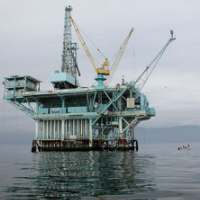California Offshore Oil Rigs Are the World’s Best Fisheries
 Santa Barbara oil platform (photo: dsearis via Flickr)
Santa Barbara oil platform (photo: dsearis via Flickr)
When fish go shopping for a place to live, nothing appeals more to them than oil and gas platforms off the coast of California.
That was the conclusion of a report published last week in the Proceedings of the National Academy of Sciences, which found that active rigs along the coast were the best fisheries of any marine habitat studied (in scientific lingo) by an order of magnitude. That would be 10 times better than the next best competitor.
The study partially attributed the wild success of rigs as fisheries to platforms having a high amount of surface area compared to seafloor surface area. That resulted “in large amounts of habitat for juvenile and adult demersal fishes over a relatively small footprint of seafloor,” according to the report’s abstract.
The researchers measured productivity of the ecosystems they studied by surveying sites over a period of time stretching between five and 15 years. Fish abundance was measured visually and changes in biomass were estimated from those observations.
The scientists attributed the popularity of the rigs to their verticality. Rockfish, for instance, tend to seek greater depths as they age, and oil and gas rigs offered the prospect of never having to move to a new locale. But the researchers could not determine if the thriving habitat was due to higher fish productivity or its attraction to passersby.
There are more than 7,500 oil and gas platforms dotting the oceans around the world. If humankind comes to grips with the threat of global warming and actually moves away from fossil fuels, these platforms would cease production. If that happens, the report suggests, it might be a good idea to just leave them alone, rather than repurpose the eyesores as scrap metal.
The researchers also point out that new offshore wind farms may have a secondary benefit of providing new, thriving habitats without some of the drawbacks of oil and gas rigs.
Oil rig fishing has long been popular off the Gulf Coast. Home Run Fishing Charters & Lodge quotes anonymous “fishing pros” as saying it’s some of the “most exciting and best fishing in the world.” However, as Home Run points out, “oil rigs often receive bad press no thanks in part to the 2010 BP oil spill.”
Oil-rig fishing is “action-packed, always with surprises, as you never know what type of fish will be at the end of your line,” the charter company says on its website. Another one of those surprises is the condition of the fish.
A study of the West Florida Shelf after the BP Deepwater Horizon spill found fish with lesions and deformities linked to chemical signatures of oil compounds in their systems. Other studies have found that fish exposed to BP oil swim half as fast, the crab catch declined dramatically and oysters disappeared. Dolphins were found suffering from numerous maladies. Other fish avoided horrible consequences by leaving the area and not returning.
But a massive oil spill isn’t the same as the steady leakage of oil around an offshore drilling platform and the study does not touch on any possible health hazards that might accompany the world’s greatest fisheries.
In 2010, California lawmakers passed Assembly Bill 2503, which established a state program for artificial reef research and development that would allow conversion of decommissioned oil platforms into artificial reefs.
–Ken Broder
To Learn More:
California’s Most Productive Fisheries? Offshore Oil Rigs (by John Timmer, Ars Technica)
The Deepwater Horizon Oil Spill and its Aftermath (Krill Oil)
Louisiana's Oil Rigs Great Artificial Reefs! (by Jerry La Bella, The Jump)
Oil Platforms off California Are Among the Most Productive Marine Fish Habitats Globally (by Jeremy T. Claisse, Daniel J. Pondella II, Milton Love, Laurel A. Zahn, Chelsea M. Williams, Jonathan P. Williams and Ann S. Bull, Proceedings of the National Academy of Sciences)
- Top Stories
- Controversies
- Where is the Money Going?
- California and the Nation
- Appointments and Resignations
- Unusual News
- Latest News
- California Forbids U.S. Immigration Agents from Pretending to be Police
- California Lawmakers Urged to Strip “Self-Dealing” Tax Board of Its Duties
- Big Oil’s Grip on California
- Santa Cruz Police See Homeland Security Betrayal in Use of Gang Roundup as Cover for Immigration Raid
- Oil Companies Face Deadline to Stop Polluting California Groundwater





